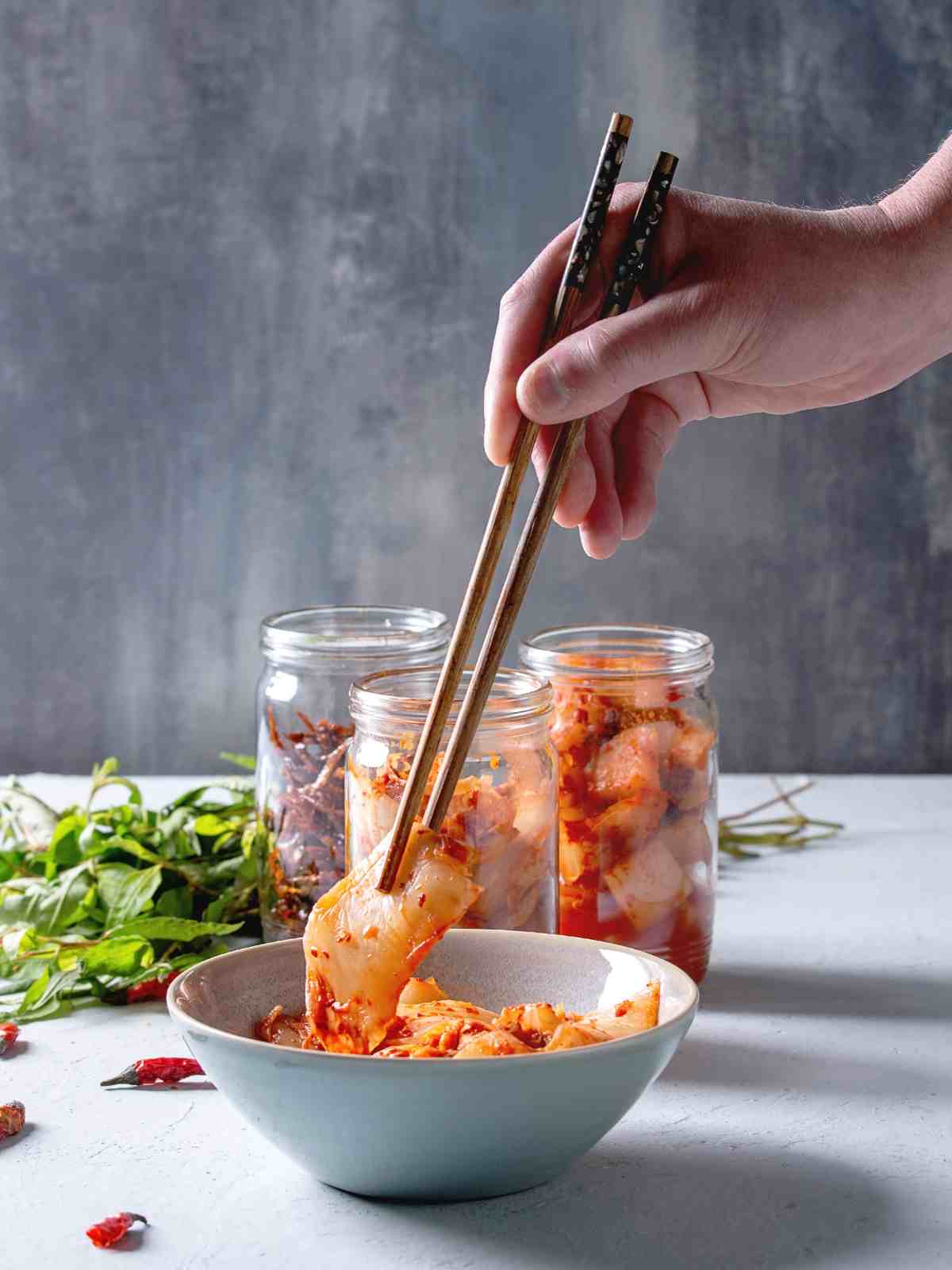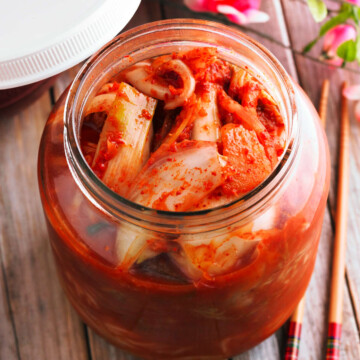Kimchi is a flavorful, traditional Korean comfort food side dish comprised of fermented vegetables such as cabbage, radishes, and scallions. To enrich its flavor even further, extra ingredients like carrots, turnips, or daikon radishes can be added to the mix.
So, What Is Kimchi? Answer: a delightful fusion of flavors provides an exciting new taste experience that will tantalize your palate when served alongside any main meal.

⬇️ Table of Contents
What Is Kimchi
Kimchi is a type of fermented cabbage that originates from Korea. It is normally made with Napa cabbage, daikon, scallions, garlic, and ginger and can be seasoned with various spices or seasonings like chili pepper flakes, fish sauce, and soybean paste.
Interestingly, North Korean kimchi tends to be less spicy and red than South Korean kimchi. This difference in taste and appearance can be attributed to the varying regional ingredients and preparation methods.

Kimchi boasts an unmistakable complexity of flavors that can range from sour to spicy, depending on the ingredients used and fermentation time. Some people describe it as containing a unique "umami" flavor.
This popular Korean fermented side dish is usually eaten alone but also adds great depth when added to stews and soups.
Kimchi's signature tangy taste comes from fermentation, making it a probiotic-rich food full of advantageous microbes.
What Does Kimchi Taste Like

Kimchi has a unique, flavorful profile that is salty, spicy, and sour. It can range from light yellow to deep red color depending on the type of pepper used to make gochugaru, the main flavoring ingredient.
The spice level can vary greatly depending on fermentation but generally has a mild-to-spicy flavor.
In terms of texture, it's crunchy with a slightly soft center due to its fermentation process. Its smell and flavor are pungent, with a slight funkiness characteristic of fermented foods.
The combination of chili pepper, garlic, ginger, and other seasonings gives Kimchi its signature flavor profile.
Is Kimchi Spicy
So, yes - Kimchi is typically quite spicy - but that doesn't mean milder versions cannot be found to suit your preference.
Generally regarded as a spicy dish, most grocery store-bought brands also come with that spiciness warning. That said, milder variations exist if you want to enjoy the unique flavors without all the heat.

History of Kimchi
Kimchi is an ancient Korean dish that has been enjoyed for centuries. Traditionally made of fermented vegetables, its flavor and preparation method vary depending on region and season.
Originating from the 7th century, it was a practical way to preserve food during the winter months when fresh produce was hard to come by.
In 2012, the Chinese government effectively banned the import of Korean kimchi through government regulations. This move has had significant implications on the trade and consumption of this beloved Korean dish.
Despite these restrictions, kimchi continues to be a significant part of Korean culinary culture and is enjoyed by people all over the world.
Common Types of Kimchi
Recipes to use kimchi at home:
- Baechu kimchi is made with napa cabbage.
- Sobagi (cucumber kimchi)
- Dongchimi (radish)
- Chonggak Kimchi (made with white radish)
- Kimchi jjigae is a popular and traditional Korean stew that features kimchi as its main ingredient. The dish typically includes ingredients such as onion, garlic, pork, or seafood, along with fermented cabbage.

If you're new to Kimchi, start with a milder variety like baechu Kimchi or oi sobagi. Once you've acquired a taste for it, you can try more assertive flavors like chonggak Kimchi or dongchimi.
Kimchi is often eaten as a side dish or condiment but can also be used in recipes like Kimchi fried rice or kimchi soup. It can also be enjoyed simply as a fermented cabbage kimchi snack.
Homemade Kimchi Recipe
Making kimchi is easy and inexpensive. Here is a basic recipe that you can use as a starting point:
Kimchi Ingredients:
- Napa Cabbage: 2 Heads, cut into strips
- Garlic: cloves, minced
- Ginger Root: ¼ cup, grated
- Fish Sauce: ⅓ cup
- Sugar: ¼ cup
- Korean Red Pepper Flakes / Gochugaru (Korean Spice Blend: 1 tablespoon
- Gochujang Paste: ½ cup
- Carrot: ½ cup, julienned
- Daikon Radish: ½ cup, julienned
Instructions:
1. Combine the garlic, ginger, fish sauce, sugar, and red pepper flakes in a medium bowl until combined.
2. In a large bowl, combine the cabbage strips, carrots, and daikon.
3. Pour the marinade over the vegetables and mix until all of them are evenly coated.
4. Place the vegetables in a glass jar and press down firmly until they are completely submerged in the marinade.
5. Close the lid of the jar and let it ferment at room temperature for 2-3 days, depending on your preference.
6. Once fermented, transfer to refrigerator and enjoy!
The most complete list of Kimchi recipe ingredients is attached to the recipe card below...
Fermenting Kimchi
The process involves salting and seasoning various vegetables and then storing them in a jar to ferment at room temperature. This helps to draw out the complex flavors of the ingredients and develop a unique taste.
It takes around 2-4 days for Kimchi to ferment before it can be enjoyed. Throughout the fermentation process, it is important to check on the flavor and smell of your Kimchi regularly, as this will let you know when the fermenting is complete.
The most important factor in fermentation is temperature and oxygen exposure. Creating the perfect balance is the mastery of making Kimchi.
For example, storing it on a counter at room temperature will develop much faster than in a cold refrigerator which retards the speed of the bacteria growth (good bacteria).
Lactobacillus bacteria (the good guys!) convert sugars into lactic acid, which preserves the vegetables and gives them that wonderful, tangy flavor.
Where To Buy
Health food stores, Asian markets, or regular grocery stores often carry Kimchi in their specialty or refrigerated items section.
Storing Kimchi
For the best quality, storing kimchi at home should be tightly sealed in a container with an airtight lid and kept in the refrigerator, where it will remain fresh for up to two weeks.
Refrigeration greatly extends your Kimchi's life while keeping its unique sour taste, ensuring you'll always have an enjoyable dining experience.
After this two-week period, you can store kimchi in the freezer, where it can last up to a year before needing to be discarded.
FAQs
What Is Gochugaru?
Gochugaru adds flavor and heat to the Kimchi and can be divided into three types according to heat profile: mild, medium-hot, and hot.
Does Kimchi Go Bad
Yet when exposed to warmer temperatures at room temperature or more, Kimchi's fermentation process will speed up significantly and spoil it quickly - so if you decide to store it outside the refrigerator, make sure you use it promptly.
Is Kimchi Good for You
However, it's important to note that one should eat Kimchi in moderation due to its high sodium content.
o while it may not necessarily be considered a "health food," adding moderate amounts to your meals can certainly benefit your health.
📖 Recipe

How To Make Kimchi
Suggested Equipment
Ingredients
- 2 heads Napa Cabbage Washed and dried
- 1 cup Daikon Radish You can add other types of radishes for more flavor
- ½ large Onion Slice into long julianne cuts
- 2 cloves Garlic Sliced and minced (use both)
- ½ cup Scallions Replace with Green Onion if needed
- 1 tablespoon Ginger (minced)
- ¼ cup Fish Sauce
- ½ cup Gochujang Paste Use more if needed
- 1 tablespoon Gochugaru (Korean Spice Blend)
- 3 tablespoon Sriracha Sauce
- 1 teaspoon Sea Salt
- 1 teaspoon White Sugar
- 1 tablespoon Rice Wine Vinegar
- ½ tablespoon Toasted Sesame Oil
Instructions
How To Make Homemade Kimchi
- Thoroughly rinse the cabbage under cold water and pat dry. Cut into 2-inch pieces and set aside. When making the cuts think about eating the kimchi. Cut it to a reasonable size for your mouth.Second method: Keeping the cabbage leaves long and intact for presentation. You'll need large tall jars.Peel and slice the onion into julienne (long strip cuts)
- In a large bowl, combine the cabbage, radishes, scallions, ginger, garlic, salt, sugar, fish sauce, gochujang paste, Gochugaru (Korean Spice Blend), Sriracha Sauce, rice vinegar, and toasted sesame oil. Mix all ingredients and create a paste.
- Mix well and massage the cabbage leaves with the spicy paste. Wear plastic gloves to protect your skin.Pack the mixture into jars or containers and store it in the fridge for at least 2 days before serving.
Fermentation of Kimchi
- The fermentation process involves natural bacteria in vegetables combined with oxygen and yeast to create an acidic concoction. This creates an environment that is ideal for beneficial microorganisms as they break down the sugar and proteins of the vegetables, making them more easily digestible and creating unique flavors. Rule to follow, the longer the kimchi sits, the more days that pass, the stronger the flavor profile will become. Experiment to find your perfect number of days to perfection.Kimchi will keep in the fridge for up to 3 weeks with a fresh pop of flavor.Long-term storage can go to 3 months if properly stored in the refrigerator. The longer, the more the fermentation flavor and funk will be developed. Serve as a side dish or add to soups, stews, and other dishes. Enjoy!
Notes
Kimchi Tips
1. Traditional kimchi is a flavorful Korean dish made of cabbage and other vegetables that have been fermented with spices like garlic, ginger, and chili pepper. 2. This spicy side dish is high in vitamins A and C, as well as beneficial probiotics that can promote gut health. 3. For those new to kimchi, it's best to start with a milder variety and add more spice over time. Kimchi can be stored in the refrigerator for up to a month, making it an ideal dish to prepare ahead of time. 4. Serve kimchi with rice, noodles, or on its own as a side. It can also be used as a topping for burgers or tacos. If you don't like spicy food, milder ingredients can still be enjoyed as kimchi without any chili pepper at all. 5. When buying kimchi, look for brands that use traditional fermentation methods to avoid added preservatives or artificial flavors. 6. Kimchi is a healthy, delicious dish sure to please any palette. So give it a try and see for yourself!Posts To Visit
What Peppers Are In Sriracha Sauce?
How To Cook Bok Choy | Stir-Fry
Habanero Peppers🌶️ Uses, Facts, Recipes
What Is Sushi Maki? 🍣 Types | How-To Make
How Hot Are Jalapeño Peppers: 9 Types
Types of Asian Pears | A to Z | Defined | Photos





Leave a Reply